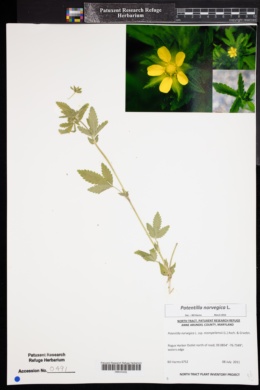Potentilla norvegica
|
|
|
|
Family: Rosaceae
Norwegian Cinquefoil
[Fragaria parviflora Lam., morePotentilla dichotoma , Potentilla flexuosa Raf., Potentilla norvegica var. conferta Kuntze] |
Stout, leafy annual to short-lived perennial, the stem mostly branched and many-fld, hirsute below, subtomentose above; lfls 3, elliptic to broadly obovate, to 8 cm, crenate; fls yellow, nearly 1 cm wide, the pet nearly as long as the sep; bractlets and sep lance- ovate, subequal at anthesis, the sep accrescent in fr and to 15 mm; stamens usually 20; anthers 0.3 mm; achenes flattened, 1 mm, usually marked with curved longitudinal ridges; 2n=42, 56, 70. In a wide variety of habitats; circumboreal, s. in Amer. to S.C., Tenn., Tex., and Calif. June-Aug. The native American plants tend to differ slightly from the European ones, and have been segregated as P. monspeliensis L. or P. norvegica var. hirsuta (Michx.) Torr. & A. Gray, but no clear distinction can be made, and the Eurasian phase has also apparently been intr. into our range. Gleason, Henry A. & Cronquist, Arthur J. 1991. Manual of vascular plants of northeastern United States and adjacent Canada. lxxv + 910 pp. ©The New York Botanical Garden. All rights reserved. Used by permission. General: Annual, biennial, or short-lived perennial, 10-70 cm tall; stems few to several, clustered, erect or ascending, simple or branched in the upper part; herbage hirsute, the hairs stiff, spreading; taproot slender. Leaves: Mostly cauline, alternate, trifoliate, leaflets broadly oblanceolate to obovate, 1.5-4 cm long, the terminal leaflet longer than the lateral pair and borne on a petiolule, surfaces spreading-hirsute, paler beneath, margin shallowly lobed, toothed, or coarsely crenate; stipules ovate, margins entire to toothed; petiole 1.5-6 cm long. Flowers: Inflorescence an open cyme, the branches ascending; flowers few to several; hypanthium shallowly cup-shaped, silky-pubescent externally; bractlets lanceolate, 2-5 mm long; sepals broadly lanceolate, 4-6.5 mm long; petals obovate, 4-6 mm long, yellow; stamens about 20; pistils numerous, the style 1.7-2.3 mm long; flowers June- September. Fruits: Achene, 0.8-1.1 mm long, light brown, often becoming slightly wrinkled with maturity. Ecology: Meadows, streambanks, lake and pond margins, ditches; 1800-2900 m (6000-9500 ft); Apache, Coconino, Greenlee, and Navajo counties; widely distributed throughout North America. Notes: Potentilla biennis (biennial cinquefoil) is very similar, but the herbage is glandular-pubescent, the hairs viscid- villous, soft; stamens are about 10; achenes are 0.5-0.7 mm long, smooth, yellowish; and the style is 0.5-0.7 mm long. Potentilla rivalis (brook cinquefoil, river cinquefoil) has villous herbage, not glandular; leaves are trifoliate above, 5-foliate below. Both P. biennis and P. rivalis occur in similar habitats as P. norvegica. Potentilla nivea (snow cinquefoil) is perennial, mat- or cushion-forming, the caudex much-branched; leaves are mostly basal, usually forming a well-developed rosette, green to gray-green and spreading-hirsute above, densely white-tomentose beneath, margins of the leaflets coarsely toothed. It occurs on alpine to subalpine slopes of the San Francisco Peaks. A cold tea of P. norvegica is used by the Navajo to lessen pain. Editor: Springer et al. 2008 Potentilla norvegica is a prostrate herb with small usually single or trifoliate leaves and yellow flowers. It is found on disturbed ground at middle elevation.
From Flora of Indiana (1940) by Charles C. Deam This species is a frequent to common weed throughout the state. It is found in almost all kinds of habitats but it is not frequent in certain bottomlands. I have specimens from roadsides, cultivated and fallow fields, pastures, open woods, dry dunes, and a dense tamarack. bog. It is a pernicious weed, especially in clover fields because its seed are separated from clover seed only with difficulty. …… Indiana Coefficient of Conservatism: C = 0 Wetland Indicator Status: FAC |




































































































